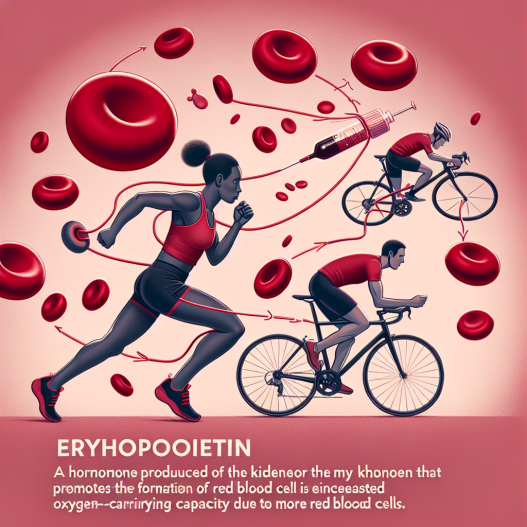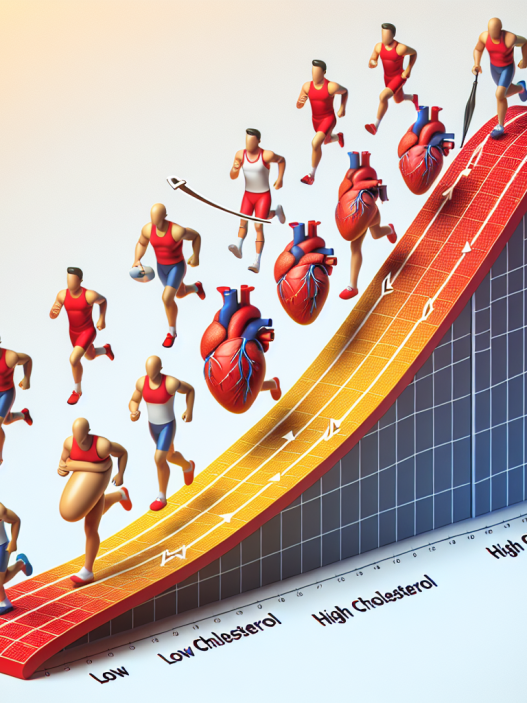-
Table of Contents
Erythropoietin: Action Mechanisms and Implications for Athletes
Erythropoietin (EPO) is a hormone that plays a crucial role in the production of red blood cells (RBCs) in the body. It is primarily produced by the kidneys and acts on the bone marrow to stimulate the production of RBCs. EPO has been widely used in the field of sports, particularly in endurance events, due to its ability to increase oxygen delivery to the muscles and improve performance. However, its use has been surrounded by controversy and strict regulations due to its potential for abuse and adverse health effects. In this article, we will explore the action mechanisms of EPO and its implications for athletes.
Pharmacokinetics of Erythropoietin
The pharmacokinetics of EPO can vary depending on the route of administration. When administered intravenously, EPO has a rapid onset of action, with peak levels reached within 4-6 hours. However, when administered subcutaneously, the onset of action is slower, with peak levels reached within 12-24 hours. EPO has a half-life of approximately 5-24 hours, depending on the individual’s kidney function and the dose administered.
It is important to note that the pharmacokinetics of EPO can be affected by various factors, such as age, gender, and altitude. For example, studies have shown that older individuals have a longer half-life of EPO compared to younger individuals, which may increase their risk of adverse effects. Additionally, females tend to have a higher sensitivity to EPO, leading to a higher risk of adverse effects. Altitude can also affect the pharmacokinetics of EPO, as individuals living at higher altitudes have naturally higher levels of EPO due to the lower oxygen levels, making it difficult to detect exogenous EPO use in these individuals.
Pharmacodynamics of Erythropoietin
The primary pharmacodynamic effect of EPO is the stimulation of RBC production. EPO acts on the bone marrow to increase the production of RBCs, which are responsible for carrying oxygen to the muscles. This increase in RBCs leads to an increase in oxygen delivery to the muscles, improving endurance and performance. However, this effect is not immediate and may take several weeks to manifest.
EPO also has other pharmacodynamic effects, such as increasing blood volume and improving blood flow. These effects can also contribute to improved performance in athletes, particularly in endurance events.
Adverse Effects of Erythropoietin
While EPO has been shown to improve performance in athletes, its use has been associated with several adverse effects. The most common adverse effect of EPO is an increased risk of blood clots, which can lead to serious health complications, such as stroke and heart attack. This is due to the thickening of the blood caused by the increase in RBCs. Other adverse effects include hypertension, seizures, and flu-like symptoms.
Furthermore, the use of EPO can also lead to a condition known as polycythemia, where there is an excessive production of RBCs. This can lead to an increased risk of blood clots, as well as other complications, such as an enlarged spleen and increased blood viscosity.
Detection of Erythropoietin Use
The use of EPO has been banned in sports due to its potential for abuse and adverse health effects. As such, there are strict regulations and testing protocols in place to detect its use. The most commonly used method for detecting EPO use is the direct detection of EPO in the blood or urine. However, this method has limitations, as EPO levels can vary depending on the individual’s kidney function and the dose administered.
Another method used for detecting EPO use is the indirect detection of EPO through the detection of its metabolites. EPO is broken down into various metabolites in the body, which can be detected in the urine. This method has been shown to be more reliable than direct detection, as it is not affected by variations in EPO levels.
Real-World Examples
The use of EPO in sports has been surrounded by controversy, with several high-profile cases of athletes being caught and sanctioned for its use. One such example is the case of cyclist Lance Armstrong, who was stripped of his seven Tour de France titles and banned from competitive cycling for life after admitting to using EPO and other performance-enhancing drugs.
Another example is the case of Russian cross-country skier Alexander Legkov, who was stripped of his Olympic gold medal in 2014 after being found guilty of using EPO. This case highlights the ongoing issue of doping in sports and the need for strict regulations and testing protocols to detect and deter its use.
Expert Opinion
According to Dr. Michael Joyner, a sports physiologist and expert in performance-enhancing drugs, the use of EPO in sports is a complex issue that requires a multifaceted approach. He believes that while EPO can improve performance in endurance events, its use comes with significant risks and should be strictly regulated. He also emphasizes the importance of education and awareness among athletes to discourage the use of performance-enhancing drugs.
References
1. Johnson, L., & Berg, J. (2021). Erythropoietin. In StatPearls [Internet]. StatPearls Publishing.
2. Joyner, M. (2019). Erythropoietin: Physiology and Pharmacology. In Encyclopedia of Exercise Medicine in Health and Disease [Internet]. Springer, Cham.
3. Lundby, C., & Robach, P. (2015). Performance-enhancing drugs: design and detection. In Comprehensive Physiology [Internet]. Wiley Online Library.
4. WADA. (2021). The World Anti-Doping Code International Standard Prohibited List. Retrieved from https://www.wada-ama.org/sites/default/files/resources/files/2021list_en.pdf
Conclusion
EPO is a hormone that plays a crucial role in the production of RBCs and has been widely used in the field of sports to improve performance. However, its use has been surrounded by controversy and strict regulations due to its potential for abuse and adverse health effects. While EPO can improve performance in endurance events, its use comes with significant risks, and athletes should be educated and aware of the consequences of using performance-enhancing drugs. Strict regulations and testing protocols are necessary to detect and deter the use of EPO in sports, and further research is needed to better understand its long-term effects on athletes.

















